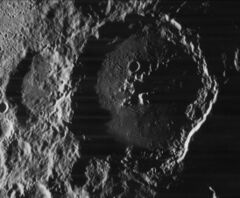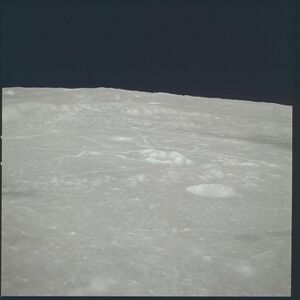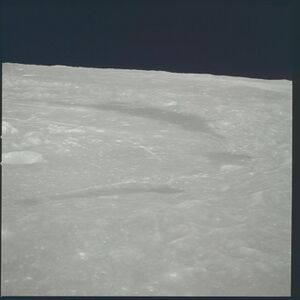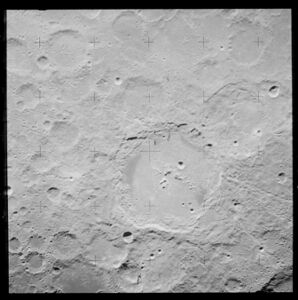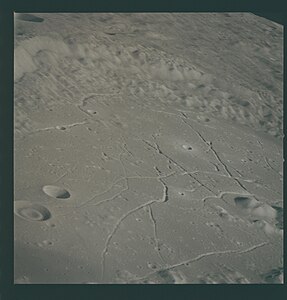Astronomy:Humboldt (crater)
 Apollo 15 image | |
| Diameter | 199.46 km (123.94 mi) |
|---|---|
| Depth | Unknown |
| Colongitude | 254° at sunrise |
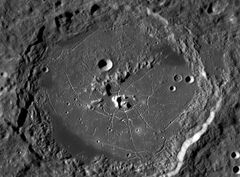
Humboldt is a large lunar impact crater that is located near the eastern limb of the Moon. Due to foreshortening this formation has an extremely oblong appearance. The actual shape of the crater is an irregular circle, with a significant indentation along the southeastern rim where the prominent crater Barnard intrudes. To the north-northwest of Humboldt is the large crater Hecataeus. Phillips is attached to the western rim. The rim of Humboldt is low, worn, and irregular in outline. The central peak forms a range on the crater floor. The floor surface contains a network of rilles forming a pattern of radial spokes and concentric arcs. There are also some dark patches located near the walls to the northeast, northwest, and southeast. There is a chain of craters leading from the northwest crater rim to a distance almost as long as the crater is wide. This formation is designated Catena Humboldt. Due to its location near the lunar limb, little detail was known about this crater until it was photographed by orbiting spacecraft (mainly Lunar Orbiter 4).
The crater was named after German philologist Wilhelm von Humboldt by the IAU.[1]
Humboldt is one of the largest craters of Upper (Late) Imbrian age.[2]
Satellite craters
By convention these features are identified on lunar maps by placing the letter on the side of the crater midpoint that is closest to Humboldt. Humboldt N is the largest crater within Humboldt itself, located north of the central peak. Humboldt B is located to the south of Humboldt, on the west rim of the crater Barnard.
| Humboldt | Latitude | Longitude | Diameter |
|---|---|---|---|
| B | 30.9° S | 83.7° E | 21 km |
| N | 26.0° S | 80.5° E | 14 km |
Catena Humboldt
Catena Humboldt is a crater chain that extends northeast from crater Humboldt, and it is approximately 162 km long. It was named by the IAU in 1976.[3] It passes between the craters Gibbs and Schorr.
Apollo 12 Views
The Apollo 12 mission in 1969 obtained many photographs of Humboldt crater. In the photos below, the central peaks appear white because of the high-Sun elevation angle. The arcuate fractures within Humboldt are evidence of the forces working on the surface of the Moon to change the lunar topography.[4]
Apollo 15 Views
The Apollo 15 mission in 1971 obtained many more photographs of Humboldt crater.
Eastern crater floor. The mare-type material on the floor contains radial cracks and concentric rilles. A dark-halo area is visible at the lower left corner. Low hills of material that resemble the central peak protrude through the smooth crater floor. Bright-halo craters are also evident. The "doughnut" filling of the crater at the left margin is a rare feature.[5]
References
- ↑ Humboldt, Gazetteer of Planetary Nomenclature, International Astronomical Union (IAU) Working Group for Planetary System Nomenclature (WGPSN)
- ↑ The geologic history of the Moon. USGS Professional Paper 1348. By Don E. Wilhelms, John F. McCauley, and Newell J. Trask. U.S. Government Printing Office, Washington: 1987. Table 11.2.
- ↑ Catena Humboldt, Gazetteer of Planetary Nomenclature, International Astronomical Union (IAU) Working Group for Planetary System Nomenclature (WGPSN)
- ↑ Apollo 12 Preliminary Science Report, NASA Special Publication 235, 1970.
 This article incorporates text from this source, which is in the public domain.
This article incorporates text from this source, which is in the public domain.
- ↑ Apollo 15 Preliminary Science Report NASA Special Publication 289, 1972.
 This article incorporates text from this source, which is in the public domain.
This article incorporates text from this source, which is in the public domain.
- Andersson, L. E.; Whitaker, E. A. (1982). NASA Catalogue of Lunar Nomenclature. NASA RP-1097.
- Blue, Jennifer (July 25, 2007). "Gazetteer of Planetary Nomenclature". USGS. http://planetarynames.wr.usgs.gov/.
- Bussey, B.; Spudis, P. (2004). The Clementine Atlas of the Moon. New York: Cambridge University Press. ISBN 978-0-521-81528-4.
- Cocks, Elijah E.; Cocks, Josiah C. (1995). Who's Who on the Moon: A Biographical Dictionary of Lunar Nomenclature. Tudor Publishers. ISBN 978-0-936389-27-1. https://archive.org/details/isbn_9780936389271.
- McDowell, Jonathan (July 15, 2007). "Lunar Nomenclature". Jonathan's Space Report. http://host.planet4589.org/astro/lunar/.
- Menzel, D. H.; Minnaert, M.; Levin, B.; Dollfus, A.; Bell, B. (1971). "Report on Lunar Nomenclature by the Working Group of Commission 17 of the IAU". Space Science Reviews 12 (2): 136–186. doi:10.1007/BF00171763. Bibcode: 1971SSRv...12..136M.
- Moore, Patrick (2001). On the Moon. Sterling Publishing Co. ISBN 978-0-304-35469-6. https://archive.org/details/patrickmooreonmo00patr.
- Price, Fred W. (1988). The Moon Observer's Handbook. Cambridge University Press. ISBN 978-0-521-33500-3.
- Rükl, Antonín (1990). Atlas of the Moon. Kalmbach Books. ISBN 978-0-913135-17-4.
- Webb, Rev. T. W. (1962). Celestial Objects for Common Telescopes (6th revised ed.). Dover. ISBN 978-0-486-20917-3. https://archive.org/details/celestialobjects00webb.
- Whitaker, Ewen A. (1999). Mapping and Naming the Moon. Cambridge University Press. ISBN 978-0-521-62248-6.
- Wlasuk, Peter T. (2000). Observing the Moon. Springer. ISBN 978-1-85233-193-1.
External links
 |
